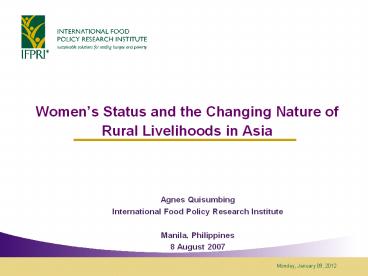Women - PowerPoint PPT Presentation
1 / 12
Title: Women
1
Womens Status and the Changing Nature of Rural
Livelihoods in Asia
- Agnes Quisumbing
- International Food Policy Research Institute
- Manila, Philippines
- 8 August 2007
2
Diversity and change
- It is difficult to characterize womens status
in Asia because womens conditions within Asia
are very diverse, and they are also changing - This presentation
- Presents a snapshot of womens status in Asia
based on the World Gender Gap Report 2006 - Summarizes returns to closing the gender gap in
terms of reducing child malnutrition, and
increasing incomes and productivity - Identifies three trends in rural livelihoods
- Based on these trends, discusses appropriate
policies and interventions to empower women
3
Contrasts and contradictions
- Gender Gap Index 2006 (Hausman, Tyson, and Zahidi
2007) examines the gap between men and women in
115 countries,in four categories - economic participation and opportunity
- educational attainment
- health and survival
- political empowerment
- Although the Philippines is among top 10
countries, out of 8 regions, Asia ranks third
from the bottom overall - Lowest performance on the health and survival
subindex - Second to the lowest in the economic opportunity
and participation subindex - Third from the lowest in the educational
attainment subindex.
4
These results driven by countries with large
populations
- China ranks 114 out of 115 because of sex ratio
at birth, missing women - Bangladesh, India, Pakistan large disparities
between men and women in all four areas of the
index - Why should we care?
- Evidence worldwide shows that increasing
resources controlled by women yields large
benefits in reducing child malnutrition and
increasing rural incomes and productivity
5
Reducing child malnutrition The Asian Enigma
- Why is South Asias child malnutrition rate so
much higher than Sub-Saharan Africas, when it
does so much better with respect to many of the
long-accepted determinants of child nutritional
status, such as national income, democracy, food
supplies, health services, and education?
(Ramalingaswami et al. 1996)
6
Child malnutrition and womens status across
regions
Percentage of children under 5
Indicators of womens status
Source Smith et al. 2003
7
The link between womens status and child
malnutrition
- Regression analysis shows that womens status has
a significant, positive effect on childrens
nutritional status in all three regions. - Womens status improves child nutrition because
women with greater status have better nutritional
status, are better cared for themselves, and
provide higher-quality care to their children. - Womens status has the most influence where it is
lowest. The strongest effect is found in South
Asia followed by Sub-Saharan Africa, and it is
weakest in Latin America and the Caribbean.
8
Increasing rural incomes and productivity
- In Bangladesh, untargeted technology
dissemination was more likely to benefit men and
better-off households (Hallman, Lewis, and Begum
2007). Efforts designed to reach women within
poor householdssuch as through NGO provision of
training and credit for vegetable
improvementachieved greater impacts on poverty. - In China, where women-managed households have
equal access to family labor, quantity and
quality of land, irrigation, and credit, there is
no significant difference in plot-level crop
revenues between men and women-managed farms (de
Brauw et al. 2007). - In the rural Philippines, where girls have higher
educational attainment than their brothers, they
are more likely to enter nonagricultural
occupations and earn higher incomes from
nonagriculture than from farming (Quisumbing,
Estudillo, and Otsuka 2004).
9
Three trends in rural livelihoods
- Increasing male migration from rural to urban
areas - Declining importance of agriculture and growth of
nonfarm sector - Increasing female migration to urban areas (and
overseas)
10
Policies to empower women will differ by context
- Areas of male outmigration
- Ensure access to land and credit
- Economic development strategies that encourage
competitive and efficient markets - Female agricultural extension agents to deliver
technology and information directly to women
- Areas of declining importance of agriculture
- Reduce barriers to female participation in
nonfarm enterprises and nonfarm employment - Invest in womens human capital through schooling
and continuing education programs - Access to credit, markets, and information
11
Policies and context
- Areas of female outmigration
- Invest in womens education
- Encourage competitive and efficient labor markets
- Invest in infrastructure to enable families to
maintain social support networks (roads,
communications, banking)
12
General policies
- Extend and strengthen schooling systems in rural
areas - Promote competition in non-farm labor markets so
as to eliminate discrimination against women - Reform property rights systems to be more
equitable towards women - Develop agricultural technologies which increase
the returns to female labor, whether through
increased demand or increased labor productivity.































